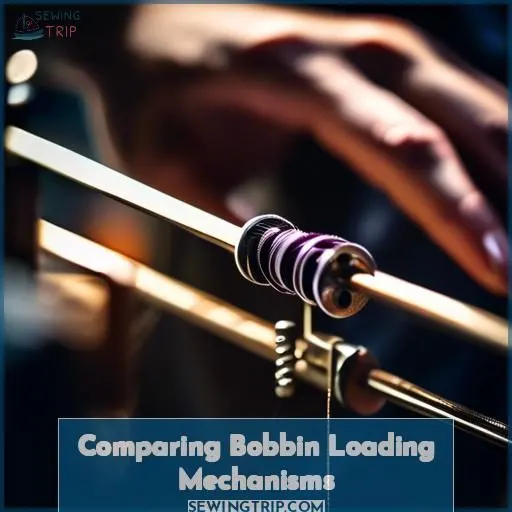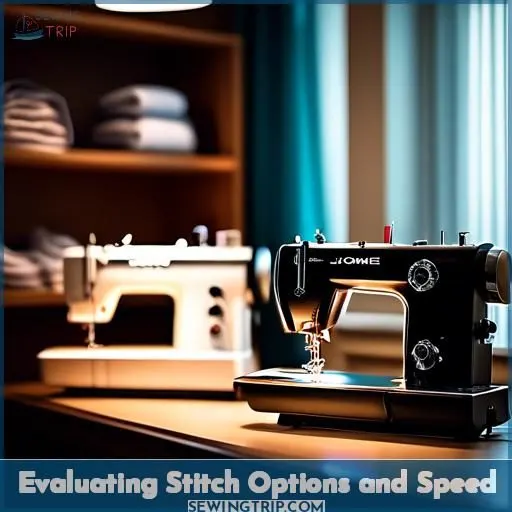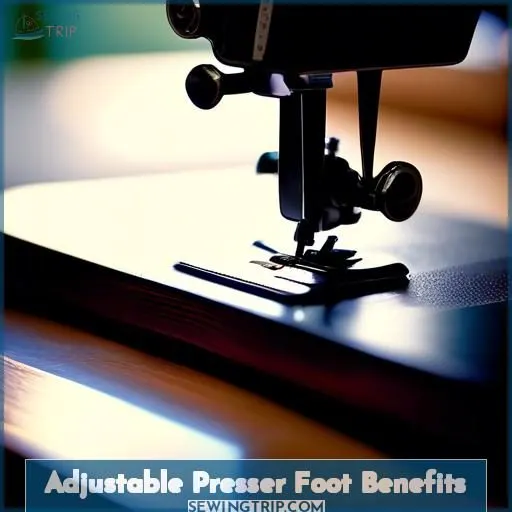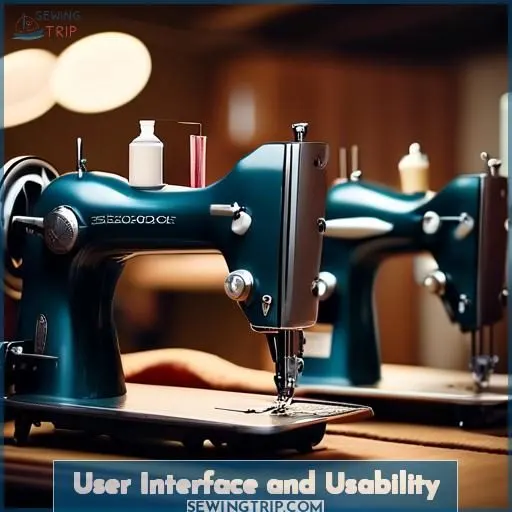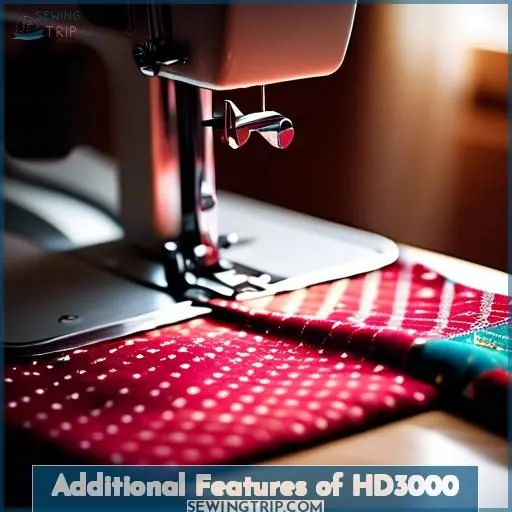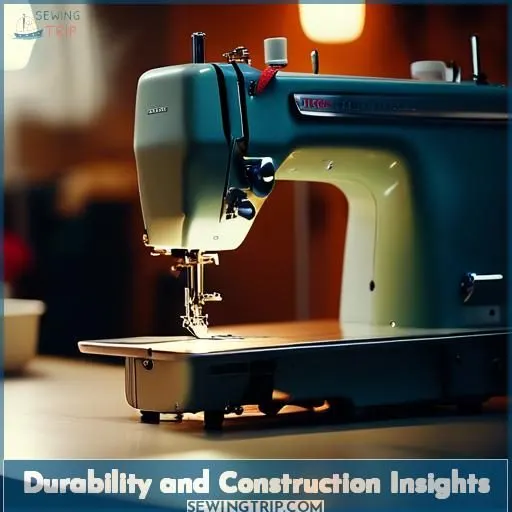This site is supported by our readers. We may earn a commission, at no cost to you, if you purchase through links.
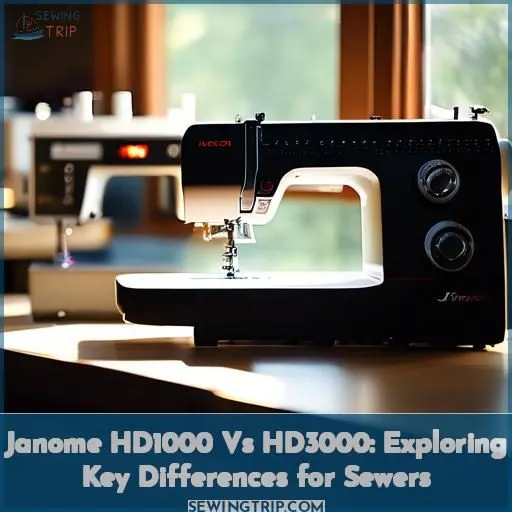
The Janome HD3000 and HD1000 are both capable sewing machines with distinct differences.
The HD3000 offers a top-loading bobbin for better visibility and an easier loading process. It also provides a wider stitch variety (18 vs 14) and a higher maximum speed of 860 stitches per minute, making it more suitable for beginners.
The HD3000’s adjustable presser foot allows for better fabric handling and stitch consistency, especially when sewing thick materials. Additionally, the HD3000’s intuitive controls and user-friendly features, such as built-in storage compartments, contribute to a more streamlined sewing experience.
By exploring these key differences, you’ll gain valuable insights to determine the machine that best suits your sewing needs.
Table Of Contents
Key Takeaways
- The Janome HD3000 offers a top-loading bobbin for better visibility and ease of loading, as well as a wider stitch variety and higher maximum speed, making it more suitable for beginners.
- The HD3000’s adjustable presser foot allows for better fabric handling and stitch consistency, especially when sewing thick materials.
- The HD3000’s intuitive controls and user-friendly features, such as built-in storage compartments, contribute to a more streamlined sewing experience.
- The HD3000’s stitch variety and speed are more comprehensive than the HD1000, with 18 stitches and a maximum speed of 860 stitches per minute, while the HD1000 has 14 stitches and a maximum speed of 800 stitches per minute.
Comparing Bobbin Loading Mechanisms
When considering the Janome HD1000 vs. HD3000 sewing machines, one key difference is their bobbin loading mechanisms. While the HD1000 features a front-loading bobbin, the HD3000 opts for a top-loading design, which many users find more convenient and easier to access.
Front-loading in HD1000
When you’re working with the Janome HD1000, you’ll notice the bobbin is front-loaded. This means you’ll need to drop the bobbin into the machine, and it’s not as visible as a top-loading bobbin. The threading process is a bit more involved, and you may find the stitch settings a bit limited.
Some users have reported that the HD1000 can wobble slightly, which can affect your stitch quality. However, the front-loading bobbin system is a common feature in many sewing machines, and it’s not unique to the HD1000.
Top-loading in HD3000
Top-loading in HD3000 is a game-changer for sewers. Here’s why:
- Bobbin Visibility: With a top-loading bobbin, you can easily see your thread and adjust it as needed. No more guessing or fumbling around.
- Thread Access: The top-loading design allows for quick and easy thread access. No more struggling to get to the bobbin.
- Loading Ease: The intuitive placement of the bobbin makes loading a breeze. No more frustration with front-loading mechanisms.
These features, combined with the adjustable foot pressure, make the HD3000 a heavy-duty machine that’s easy to use and perfect for sewers who value convenience and ergonomic design.
Evaluating Stitch Options and Speed
Regarding stitch diversity, the HD3000 provides considerably more possibilities with 18 stitches in contrast to the HD1000’s 14 stitches. Moreover, the HD3000 is capable of sewing at a maximum speed of 860 stitches per minute, exceeding the HD1000’s maximum of 800 stitches per minute.
Stitch Variety in HD1000 and HD3000
Regarding stitch variety, the Janome HD3000 surpasses the HD1000. The HD3000 presents a more comprehensive range of choices for your sewing projects, with 18 decorative stitches. In contrast, the HD1000 possesses 14 stitches, which remains a respectable selection but not as expansive.
Both machines are appropriate for heavy-duty sewing. However, the HD3000 is more suitable for beginners owing to its user-friendly stitch settings. The HD3000 also boasts a one-step buttonhole, which can prove advantageous for various fabric types. The stitch settings on the HD3000 are more intuitive and easier to operate, making it an ideal choice for those seeking a versatile sewing machine.
Stitches Per Minute Comparison
With regard to sewing speed, the Janome HD3000 boasts a top speed of 860 stitches per minute, making it ideal for both beginners and experienced sewers. In contrast, the HD1000 has a lower top speed of 800 stitches per minute. This speed difference, coupled with the HD3000’s adjustable presser foot, enhances fabric handling and stitch consistency. However, both machines offer heavy-duty construction and stability for various sewing projects.
- Speed Comparison: HD3000 has a higher stitch count per minute (860) compared to HD1000 (800).
- Beginner Suitability: HD3000 is suitable for beginners due to its quiet operation and ease of use.
- Advanced Features: HD3000 offers an adjustable presser foot, which HD1000 lacks.
- Stitch Quality and Maintenance: Both machines require regular maintenance but offer high-quality stitches.
Adjustable Presser Foot Benefits
The HD1000 lacks an adjustable presser foot, which can make it more challenging to manage thick fabrics and guarantee consistent stitching. In contrast, the HD3000’s adjustable presser foot empowers you to enhance fabric handling and stitch quality, providing you with greater control over your sewing undertakings.
Absence in HD1000
Venturing into the realm of sewing with the HD1000, you’ll encounter a fixed presser foot, akin to navigating a murky chamber—insufficient illumination for your creations. Whether you’re traversing through vinyl thickets or leather terrains, the lack of a feed foot hinders your standard foot, rendering upholstery endeavors a more arduous task than a pleasurable pursuit.
Presence and Advantages in HD3000
Upgrading to the HD3000 offers several advantages, including an adjustable presser foot. This feature optimizes fabric handling and stitch consistency. The HD3000 also boasts a top-loading bobbin, which provides easy thread visibility.
It comes with a thread storage compartment and a foot storage compartment, ensuring your accessories are always within reach. With stitch selection made simple, easy threading, and a 1 amp motor for punching through thick materials, the HD3000 is a sewer’s dream.
User Interface and Usability
The user interface and overall usability are quite different between the HD1000 and HD3000. While the HD1000 has unintuitive knobs and settings as well as a threading process that’s not preferred, the HD3000 offers a more intuitive knob layout and a more natural threading experience.
Knob and Setting Intuitiveness
Regarding knob intuitiveness and setting accessibility, the Janome HD3000 emerges as a more user-friendly machine. The knobs are strategically located for effortless access, and the settings are intuitive and simple to modify. This renders the HD3000 an ideal option for those seeking a seamless sewing experience.
Conversely, the HD1000’s knobs and settings can be less intuitive, making it somewhat more challenging to operate.
Nonetheless, both machines provide a level of user friendliness that accommodates diverse sewing preferences.
Threading Differences
The HD3000 sewing machine features a top-loading bobbin, which allows for easy thread visibility and adjustment. This design is more intuitive and user-friendly, making it easier to guarantee proper thread tension and bobbin tension.
The HD1000, on the other hand, has a front-loading bobbin, which can be more challenging to monitor during sewing. This distinction in bobbin loading mechanisms notably impacts the threading experience and preference for different users.
Compared to the HD1000, threading the HD3000 sewing machine is a more natural experience. The top-loading bobbin design of the HD3000 is more intuitive and user-friendly, while the front-loading bobbin of the HD1000 can be more challenging to monitor during sewing.
Additional Features of HD3000
The HD3000 comes equipped with handy built-in storage compartments to keep your sewing essentials organized. You’ll also appreciate the intuitive stitch selection on this model, making it easy to choose the perfect stitch for your project.
Built-in Storage Compartments
Regarding built-in storage compartments, the Janome HD3000 stands out with its thoughtful design. The machine features a top that opens up to reveal stitches, thread, and bobbins. This makes it easy to access and organize your sewing materials, ensuring a clutter-free workspace. Additionally, the HD3000 includes a thread storage compartment and a foot storage compartment, further enhancing its organization options.
In comparison, the Janome HD1000 lacks built-in storage compartments. This means that users must find alternative storage solutions for their sewing materials, which can be less convenient and potentially lead to a more disorganized workspace.
In terms of overall design, the HD3000’s compact design allows for easy storage when not in use, making it a great choice for those with limited space. The HD1000, on the other hand, doesn’t have the same level of built-in storage, which may be a consideration for those who want a more organized sewing experience.
When comparing the Janome HD1000 and HD3000, it’s clear that the HD3000 offers more convenient storage options, which can be a significant advantage for sewers who want to keep their workspace tidy and efficient.
Easy Stitch Selection
Diving into the HD3000, you’ll find intuitive controls that make stitch selection a breeze, akin to flipping through your favorite cookbook to find that cherished recipe.
This mechanical sewing machine, unlike its more basic counterpart, offers a stitch variety and precision that feels like upgrading from a vintage machine to a high-tech gadget.
Preferred settings are easily accessible, ensuring your projects radiate stitch quality.
Durability and Construction Insights
When comparing the Janome HD1000 and HD3000 sewing machines, you’ll notice their all-metal bodies provide sturdiness and durability. However, the lightweight aluminum construction of both models guarantees they’re easy to move and transport, weighing just slightly more than plastic-bodied machines.
All-metal Body
The full-metal body of both Janome HD1000 and HD3000 sewing machines guarantees sturdiness and durability. While HD1000 features a full-metal construction, HD3000 has a lightweight aluminum body that’s only two pounds heavier than plastic models. This lightweight construction doesn’t affect the strength and stability of the machine, making it suitable for heavy-duty sewing tasks.
Weight and Portability Considerations
Regarding weight and portability, the Janome HD3000 emerges as a more substantial alternative, weighing 24.2 pounds compared to the HD1000‘s 15.4 pounds.
The top-loading bobbin and adjustable presser foot of the HD3000 render it a more robust and versatile option for sewing through diverse materials, including denim, garment leather, and polyester upholstery.
Conversely, if a lighter machine is desired for smaller projects or occasional use, the HD1000 may be a more suitable choice.
It’s worth noting that the Singer 4423, with its 16.5 pounds, also strikes a balance between weight and functionality.
Frequently Asked Questions (FAQs)
What is the difference in stitch length between the HD1000 and HD3000?
For example, let’s say you’re sewing some delicate chiffon and need precise stitch control. The HD3000 allows you to fine-tune the stitch length, unlike the HD1000’s more limited range, giving you the flexibility you crave.
How does the threading process differ between the two machines?
The threading process on the HD3000 is more natural and intuitive, with a top-loading bobbin that allows you to easily see the thread. In contrast, the HD1000’s front-loading bobbin makes the threading process less preferred.
What are the dimensions of the HD1000 and HD3000 in inches?
Picture a sewing machine that’s just right – not too bulky, not too slim. The HD1000 measures 15 x 7 inches, while the HD3000 is a touch larger at 16 x 8 inches. Compact enough to fit your creative space.
How does the HD3000s top-loading bobbin system compare to the HD1000s front-loading bobbin?
The HD3000’s top-loading bobbin makes it a breeze to thread and monitor your thread supply – no more fumbling with that front-loading system! You’ll appreciate the added convenience and visibility.
What are the warranty terms for the HD1000 and HD3000?
In a world where accuracy commands the highest priority, the HD1000 provides a 25-year limited warranty, while the HD3000 offers an exceptional 30-year coverage, guaranteeing an unbroken adventure through the cosmic tapestry.
Conclusion
Ultimately, the choice between the Janome HD1000 and HD3000 sewing machines comes down to your specific sewing needs. The HD3000’s top-loading bobbin, wider stitch variety, higher speed, and adjustable presser foot make it the more versatile option, particularly for beginners.
However, the HD1000 remains a solid, durable choice for those seeking a straightforward, front-loading machine.
When comparing the Janome HD1000 vs HD3000, consider your skill level, project requirements, and preferred features to determine the machine that best suits your Janome sewing needs.

